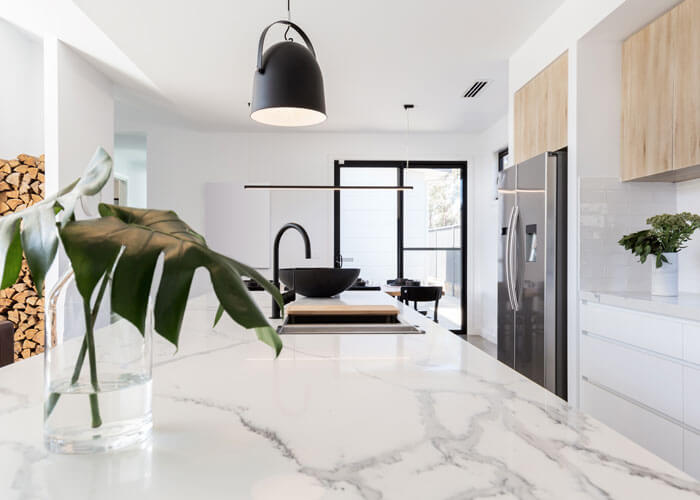
Marble countertops are more than just a part of your kitchen or bathroom; they are a statement of elegance and a testament to timeless beauty. While this material is known for its durability, it isn’t completely immune to the wear and tear of daily life.
From accidental spills causing stains to scratches and chips, these challenges can mar the perfection of your marble. But don’t worry – we specialise in natural stone countertops and can help you bring back the lustre and integrity of your marble worktops.
Whether you’re a seasoned DIY enthusiast or a novice eager to preserve the splendour of your stone, we’ve got you covered. We’ll explore the secrets behind effectively repairing your marble, ensuring that it continues to add that touch of luxury and sophistication to your space.
- Preparation for Repairing Marble Countertops
- Marble Damage Types and Repair
- Bespoke Marble Countertops With Melrosa
Preparation for Repairing Marble Countertops
Before diving into the repair process, you’ll need to prep the surface. This just helps to make sure the repair goes smoothly and you’re left with the best possible finish at the end.
Cleaning the Surface
To begin, the key to a successful repair lies in how well you prepare your marble surface. Start by thoroughly cleaning the area to eliminate any dirt, grime, or residue that could interfere with the repair process. Using a soft cloth or sponge, gently wipe down the surface with clean water.
After cleaning, it’s important to dry the marble completely. Use a soft towel or another dry cloth to pat the surface gently. This step is not just about removing moisture; it’s about preparing the marble to bond effectively with the repair materials. After you’ve used a towel, let the surface air dry for an hour or so, just to make sure all moisture is completely gone.
Lastly, pay special attention to the details. If there’s any polishing compound lingering in the grout lines or along the edges, now is the time to remove it. These small but significant areas need to be free of any substances that could hinder the repair work.
Protecting the Surrounding Areas
When fixing up your marble countertop, remember to look out for the rest of your space too. The last thing you want is accidental damage. Use an old sheet and masking tape to protect the surface you’re not working on. This way, you keep your efforts where they’re needed and the rest of your space looking great.
Marble Damage Types and Repair
Every scratch, chip, and stain on marble tells a different story, and understanding these variations is key to effective repair.
Hairline and Minor Cracks
Hairline cracks in marble countertops can be a common sight, often caused by things like temperature changes, excessive heat or repeated stress. These tiny cracks, although not immediately threatening, can diminish the beauty of your marble if left untreated. The good news is, fixing them is quite straightforward.
Here are the basic steps: Start by thoroughly cleaning the area around the crack. Once clean, use an acrylic-epoxy adhesive, ideally tinted to match your stone’s specific colour, to fill the crack. This not only repairs but also helps in achieving a seamless finish. After filling, gently smooth out the surface to make sure it blends well with the rest of the countertop.
Remember, the key here is precision and patience, ensuring the filled crack aligns perfectly with your marble’s unique colour and pattern.
Discolouration and Etching
Superficial discolouration and etching on marble can look similar, but they are fundamentally different. The discolouration is usually caused by staining from spills, while etching is a chemical reaction, often from acidic foods, such as lemons, that leaves dull marks on the surface.
To fix superficial discolouration, you can polish the affected area. It removes the top layer of the marble, revealing a fresh, unblemished surface underneath. For etching, however, a marble-safe cleaner is your best bet. It can help in gently removing these marks without causing further damage.
Understanding whether you’re dealing with discolouration or etching is important. This ensures you choose the right technique to restore your marble’s original beauty without causing additional harm.
Scratches and Gouges
Scratches and gouges are more than just surface-level issues and require a bit more attention. The approach to repairing these depends largely on their size and depth. For smaller, less severe scratches, marble repair products available in the market can be quite effective.
These products are designed to fill and blend the damaged area with the surrounding surface. However, for deeper gouges or extensive scratches, professional restoration might be necessary. Professionals have the right tools and expertise to not only fix the damage but also to ensure the repair is consistent with the rest of your marble surface.
Marble Damage Types and Repair
Sometimes, despite our best efforts, certain damages might be beyond the scope of DIY repairs. In these cases, don’t hesitate to call on our experts at Melrosa. We specialise in bespoke marble worktop replacements, ensuring that even the most extensive damage can be beautifully restored.
At Melrosa, we are more than just natural stone specialists; we are artisans, dedicated to our craft and backed by decades of experience in bringing timeless elegance to every type of home.
So, if you ever find yourself facing a marble repair challenge that seems too daunting, remember that Melrosa is just a call away. Trust us to provide not only expert solutions but also guidance and support, ensuring your marble countertops continue to be a statement of elegance in your home.